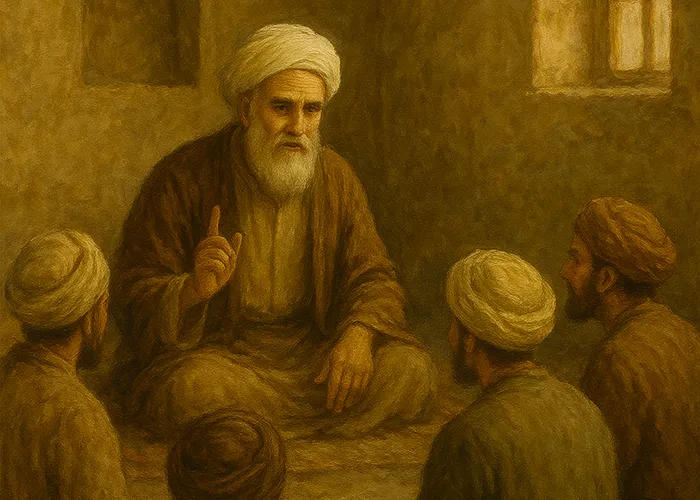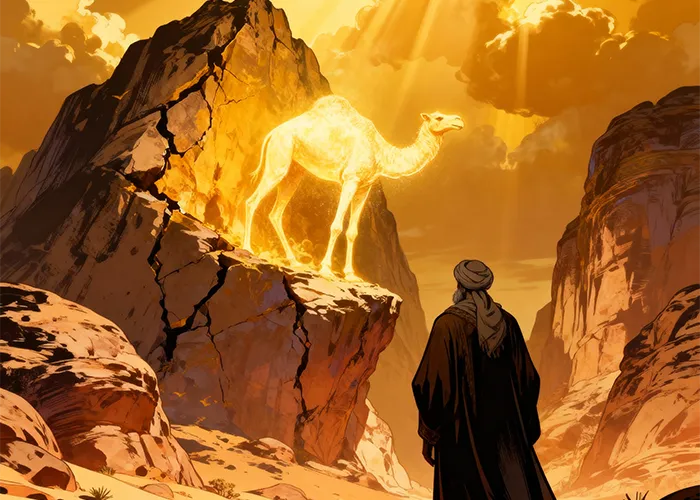The event of Ghadir Khumm
In this week’s bulletin, we aim to briefly introduce a peculiar yet significant location in Islamic history. The event of Ghadir Khumm serves as a living testimony to the truth of the Imamate of the Ahlul Bayt (peace be upon them) and is a completion of the Prophet’s (peace be upon him) mission. This event, despite historical distortions, remains the most important evidence for the immediate succession of Imam Ali (peace be upon him) in Islamic sources. Today, Ghadir teaches Muslims that to preserve pure Islam, they must follow divine leadership.
1. Where is Ghadir Khumm?
– Ghadir Khumm is an area located between Mecca and Medina in Saudi Arabia. It is situated four kilometers from Juhfa, which is approximately 200 kilometers northwest of Mecca and 300 kilometers from Medina, and is one of the five Miqat points. This region lies between two mountain ranges to the north and south, stretching from east to west, culminating at the Red Sea.
2. What is the Ghadir Khumm Event?
– The event of Ghadir Khumm occurred on the 18th of Dhul-Hijjah in the 10th year of Hijrah, following the Prophet Muhammad’s (peace be upon him) return from his final pilgrimage (Hajjat al-Wada). On this day, by divine command, the Prophet introduced Imam Ali ibn Abi Talib (peace be upon him) as his immediate successor to the Islamic community. This event is documented in both Shia sources and in numerous reliable Sunni texts.
During the years of stay in Medina, the Prophet had opportunities for only three Umra (minor pilgrimages), hence the Haj was a time for the Muslims to accompany the Messenger of Allah and learn life’s ways from the essence of creation. It was customary for pilgrims leaving Medina to pass through destinations like Qadi, Mahsib, Tan’im, Saraf, Dajnan, Mar al-Zuhran, Asfan, and Wadi Qadid until they reached Ghadir Khumm, where each pilgrim would then disperse to their respective destinations. Ghadir Khumm was the area located between Mecca and Medina.
3. How long did the Ghadir Sermon last?
– According to historical sources, the Prophet’s (peace be upon him) sermon lasted about three hours. In this sermon, he emphasized the necessity of following Ali’s (peace be upon him) leadership and outlined the dangers of deviating from this path.
4. How did Ghadir become famous?
– Arabs refer to areas that are traversed by floods and where floodwaters flow into the sea as “wadi.” Natural pools form in these paths where remaining water collects after the flood subsides. Such pits and pools are known as “ghadir.” Ghadir Khumm was a place where the paths of pilgrims diverged, after which residents of Egypt, Medina, Iraq, and Syria returned home. On the 18th of Dhul-Hijjah, the Muslim caravan reached this location, and the significant event of announcing the leadership of Amir al-Mu’minin Ali ibn Abi Talib (peace be upon him) took place on that day.
5. Why has Ghadir been forgotten?
– After the Prophet’s (peace be upon him) death, the situation at Saqifah Banu Sa’idah and political pressures diminished the significance of Ghadir. The first and second caliphs prevented the narration of the Ghadir hadith by threatening its narrators. Currently, Ghadir Khumm is not on the main path of pilgrims to the Sacred House of Allah and is less recognized than in the past. Ghadir now lies in a remote area, occasionally visited by some caravan travelers who make their way to the site, resting beside a pond left from ancient times and under the shade of tall, old trees, honoring the memory of the pivotal event of Ghadir.
6. Does Ghadir Khumm exist?
– More than 110 companions and numerous prominent Sunni narrators, such as Ahmad ibn Hanbal, Tirmidhi, and Hakim Nishaburi, have transmitted this event. Allameh Amini collected the sources of this event from 360 Sunni references in his book “Al-Ghadir.”
7. Why is Ghadir not in Nahj al-Balagha?
– Nahj al-Balagha is a collection of sermons by Imam Ali (peace be upon him) and does not necessarily cover all historical events.
However, in the sermons of Shiqshiqiyah and Qas’ah, the Imam alludes to his usurped right.
8. To whom did Fatimah (peace be upon her) recall the Ghadir sermon?
– In her Fadakiyyah sermon, Fatimah (peace be upon her) addressed the Muhajirin and Ansar present in the Mosque of Medina, referring to Ghadir and the truth of Imam Ali (peace be upon him) by saying:
“What is it with men that they openly oppose me… Am I not your mother?!”
9. What was the summary of Ghadir?
– The key statement of the Prophet (peace be upon him) at Ghadir Khumm was:
“Whoever I am his master, Ali is his master. O Allah, befriend those who befriend him and be hostile to those who are hostile to him.”
This statement is recorded in both Shia and Sunni sources such as Sahih al-Tirmidhi (Vol. 5, p. 297) and Musnad Ahmad ibn Hanbal (Vol. 4, p. 370).
10. What measures did the Prophet take for the pledge of loyalty on Ghadir?
– Constructing a Pulpit: He constructed a pulpit using the saddles of camels to ensure his voice reached everyone.
– Public Covenant: After the sermon, he asked the people to pledge allegiance to Ali (peace be upon him).
– Repeated Emphasis: He repeatedly stated, “Am I not more worthy of you than yourselves?” three times to remove any doubt.
11. What significant event occurred for Muslims on the day of Ghadir?
– The designation of the Prophet’s (peace be upon him) successor occurred by divine command. This event demonstrated that Islam is incomplete without divine leadership (Imamate).
12. Why is Ghadir important?
– Completion of Religion: According to verse 3 of Surah Al-Maidah, the religion was completed after Ghadir.
– Divine Appointment: The Imamate of Ali (peace be upon him) is a divinely appointed position, akin to Prophethood.
– Preventing Division: If Ghadir had been acknowledged, the Islamic community would not have faced disunity.
13. What is the message of Ghadir for Muslims today?
– Emphasis on Divine Leadership: Ghadir illustrates that the leadership of the community must be divinely ordained.
– Islamic Unity: Following the infallible Imam is the only way to escape disunity.
– Struggle Against Oppression: Ghadir serves as a model for resisting injustice and religious deviations.
editor's pick
news via inbox
Subscribe to the newsletter.




